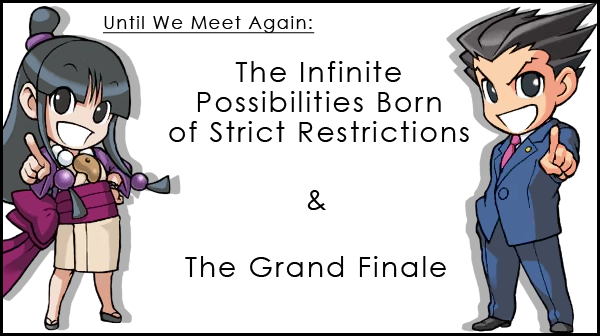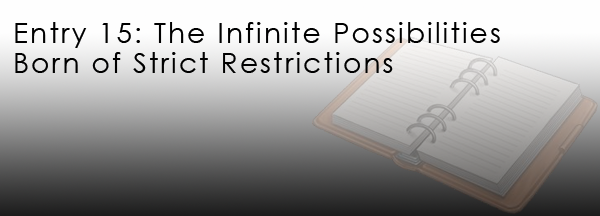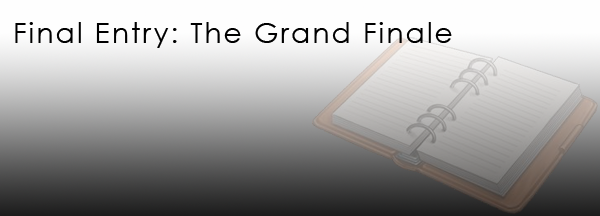
Until We Meet Again
Nov 28, 2014 // Janet Hsu
Hi everyone! As we draw closer to the release of Phoenix Wright: Ace Attorney Trilogy (which is coming out in just two short weeks!) I’m back with the last two blogs Mr. Takumi wrote for the third game back at the end of February and the beginning of March, 2004. He has some great words of wisdom for any aspiring creators, game or otherwise, so kick back and get ready for some musings from the man himself!

If you happen to have one of the Ace Attorney GBA cartridges on hand, I want you to pick it up right now.
…It’s really small, isn’t it?
The amount of data that can be stored on one of these cartridges really is as small as it physically looks. Comparatively, a CD can hold 80 times more data, and a DVD, which is slowly becoming a mainstream format, can hold an amazing 600 times more data than a GBA cartridge. At that point, a DVD almost seems to hold an “infinite” times more data than a cartridge; it’s like you could fit any amount of data you want on a single disc.
Just to squeeze the entire story into such a tiny cartridge is a tough battle we must wage each time we make a game. Honestly speaking, the thought “I wish we had that infinite amount of memory”… has actually never really crossed my mind. That’s because I believe that there is a certain kind of “fun” that can only be experienced in the face of extreme constraints. As for what that kind of “fun” is… it’s the chance to sharpen the team’s ability to find solid workarounds.
The amount of memory available to us on a GBA cartridge was actually exactly the same for all three games… But there’s a huge difference in the volume and density of information we were able to convey to the player. I’m sure you’ve realized it just by playing the games, but content-wise, AA3 is 2.3 times the size of AA1. So even though we could only store the same amount of data as AA1 on the cartridge, how did we manage to convey so much more information…? It’s all due to the research we did and the neat tricks and workarounds we figured out in the three years between the first and third game.
Programmer: “How do I create a better structure to pack the data more efficiently?”
Graphic Artist: “How do I compress the graphical data better?”
Sound and SE Designer: “How do I create good sounds using as little data as possible?”
Me: “How do I make this story more interesting?”
…There is always one person who doesn’t pitch in at all, isn’t there.
The lack of freedom that comes with constraints and restrictions is a great source of inspiration for our creators’ imagination… or is that, ingenuity. “How do we get the most out of a very limited amount of resources…?” Finding the answer to that took the combined effort of every member of every section facing that question head on. Plus, it generated a very good kind of nervous energy — the kind that gave us the power to give birth to new ideas.
Speaking of new ideas… Let’s take the example of how we came up with the opening sequences for the five episodes of AA3.
For the first and second game, our approach to the openings for each episode was to show what was happening through a series of detailed illustrations. But this time, we switched our approach to a more animated and dramatic presentation because you can keep the amount of data necessary down by using moving parts over still images. We started with the opening to Episode 2: “The Stolen Turnabout”. It employed a lot of animation, but the end result was really well-received within the team.
…It makes me want to make even better openings for the other episodes…!
That sentiment prompted everyone to start thinking of various movie effects we could implement. It was honestly, a ton of fun.
Person A: “Like, what if we created it with an old, vintage movie feel?”
Person B: “Oh, I get it! If the graphics were done with a monochrome palette, it would cut down on the amount of color data, right?”
Me: “No, no. You mustn’t underestimate how hard it is to make movie effects, you guys!”
Person A: “You really think it’s that hard? Like, I bet we could just randomly throw some vertical black lines in as noise and move them around.”
Me: “No, no, no. I mean, don’t you have any respect for the history of film noir…?”
Person B: “Good thinking! I’ll just randomly mess around with the screen’s brightness a bit then.”
Person A: “Could you throw in some dust while you’re at it? Just randomly draw some dots.”
Me: “No, no, no, no. Just stop! I won’t approve of doing things in just any old random way!”
In the end, we did give it a try and… oh! To my surprise, it really did look like the real deal!
The wonderful feeling we get when we were able to figure out a great workaround in the face of such strict restrictions is something akin to that sense of exhilaration you feel when you yell “Objection!” in a nervous witness’s sweaty face.
Restrictions were also a source of inspiration for me when I was thinking about the story. In the AA series, there have been times when a character was called upon to appear in more than one episode. I first used this trick in the last episode of AA1. The real reason I had to use it is because it was a last-ditch effort to reduce the amount of data we were using. But that desperate move gave me a new direction to take the story in.
…I see, so having characters return can have this kind of an effect on the story, huh…
The little feeling of surprise I felt when I first realized this truth is something I’ve continued to nurture and grow inside of me, and the fruit it bore was the idea to go so far as to have even one of the culprits reappear in a different episode.
So in conclusion: “What creators need is the lack of freedom that comes from restraints”… is not what I want to say. What I actually want to say is: The most important thing is to always be thinking. Our ability as people to come up with new ideas is truly infinite, and there is no way anyone or anything can set a limit on that. But because I’m such a lazy sloth, I need an outside force to push me forward or nothing would ever come to me… And that’s about the long and short of it.
——————————————————————————————————

…I want to acquaint myself with even just one more engaging mystery in my lifetime…
The story of Ace Attorney started from that one, single thought.
It’s been three years since then and both Phoenix Wright and I have learned a lot of things together along the way. I feel like even my thoughts regarding story writing have drastically changed in these three years. But despite all that, my love of a good mystery has remained the same. In the future, I’d like to continue to encounter new “surprises”… and to try to bring more of them into the world.
How was AA3, everyone? It’s been a month now since the game was released, and all of your thoughts and opinions are just now beginning to reach me.
“It was so much fun!”
Sometimes, when I hear kind words like these, I find myself gently wiping away a tear or two.
…But.
While I was happy at first…
“AA3 is the best!”
“Everything that came before this was all meant to set up the last episode of 3, huh.”
“But nothing beats the original.”
“Well, if you’re gonna rank them, I’d say it’s 1, then 3, then 2.”
“I don’t know… Because it’s really 3, then 2, then 1, you know?”
…Sometimes, when I hear opinionated words like these, I find myself gently counter-arguing to myself, “You can’t rank them, you guys! The three of them together make up the entirety of ‘Ace Attorney’!”
…Well, I never said creators aren’t a self-centered lot.
To everyone whose first experience with AA is this game, if you found 3 to be fun and interesting, I really hope you’ll go back and play 1 and 2 as well.
…Now then.
Over the course of these three years, we’ve heard the slamming of the judge’s gavel approximately 1290 times and had 13 verdicts handed down in court. Phoenix Wright has been a sweat-drenched mess approximately 562 times, slammed his desk 941 times, and yelled “Objection!” 229 times. As for me, I’ve aged 3 years, and am about to finish writing my 53rd… and final entry.
The most important aspects of any story are “Where does it begin?”… and “Where should I bring it to an end?” So where should I bring it to an end…? I believe this is that point. However, there is no “end” to the world of Ace Attorney. Phoenix, Maya, Mia, Edgeworth, and Gumshoe… I believe that even now, they’re fighting the good fight and enjoying their laughter-filled lives with one another.
No, wait. Actually, it’s probably Gumshoe’s turn to get arrested now.
As long as everyone allows the gang to live on in their hearts… Not that something as wonderful as that could ever happen, right?
I think I’ll wrap up these entries here. If we ever get the chance, I hope to see you all again. And if possible… yes, in a whole new story.
Lastly…
To everyone who has supported Ace Attorney for all these years, I’d like to express once more… my deepest and most heartfelt thanks. I really can’t thank you all enough!
2004.3.5
巧 舟

———————————————————————————————-
Thank YOU, Mr. Takumi from 2004! Without the hard work of you and your team, we wouldn’t have the games we do today.
You’ll notice he talked about the size of AA3 being 2.3 times the size of AA1. That’s because this was written before the fifth episode of AA1, “Rise from the Ashes”, was added for the Nintendo DS release. Then again, I didn’t need to tell you super-fans, did I?
It’s certainly true what Mr. Takumi said about restrictions and constraints forcing you to use your brain to come up with creative solutions. I’m sure many of you have encountered obstacles or restrictions in your own daily lives or when you are creating works of your own that have forced you to think up something you never would have otherwise. One small example from my experience on Ace Attorney is that when localizing the games, the text must fall within a T-rating according to the ESRB’s standards (Dual Destinies was a very unexpected surprise and was rated M for blood, among other things…). There’s an old saying around these parts: “You only get one free f-bomb in a T-rated game.” That’s primarily why there is no swearing in the AA games, and why when we do use that one “dammit”, it’s usually in a darn important part. It’s also made for some frustrating moments when it would’ve been so easy to just give up and use “s h i t!” or “damn it!” in the text, but the extra effort to find more interesting phrases paid off in the end, in my opinion.
Join me again next week for the final episode of “Great People Around Town: Legal Edition!” We’ve already seen all of the main characters, haven’t we? So who in the world could there be left to introduce? You’ll have to tune in to find out!
Until then!
Catch up on previous blog entries here!
-
Brands:Tags:
-

Loading...
Platforms:
